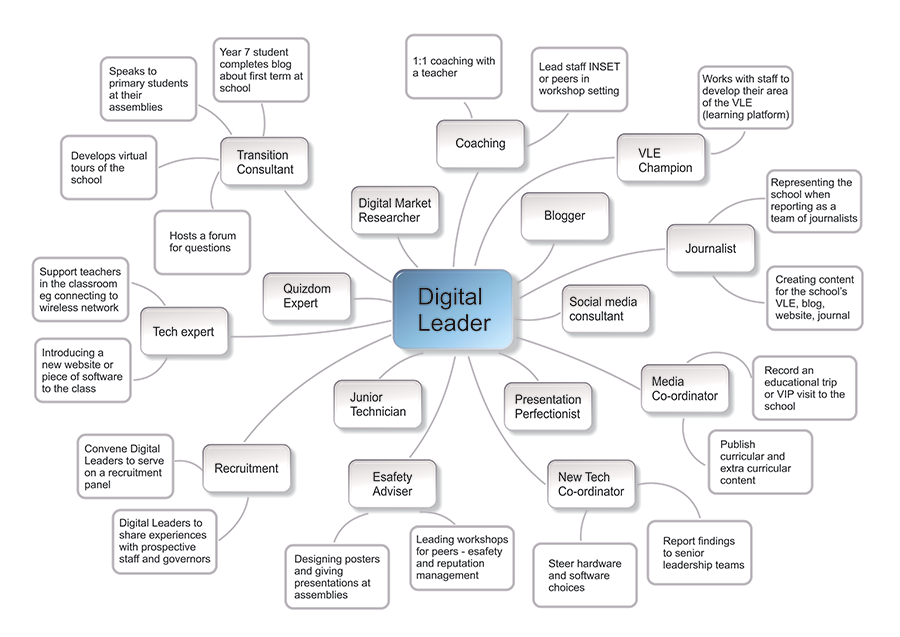 ‘Student digital leaders’ are thriving in a number of primary and secondary schools, and showing a wide range of benefits for themselves, their peers and their teachers. Glyn Barritt, Social Learning Manager SSAT reports, with advice on getting started…
‘Student digital leaders’ are thriving in a number of primary and secondary schools, and showing a wide range of benefits for themselves, their peers and their teachers. Glyn Barritt, Social Learning Manager SSAT reports, with advice on getting started…
The ‘SDL’ initiative is being led by teachers to offer leadership opportunities to students with a passion for technology, but making sure that it is embedded into all areas of school life.
The initiative was created several years ago, by classroom teachers Kristian Still and Daniel Stucke, after hearing of a similar scheme in the US. Latterly SDLs have been championed at secondary level by Mark Anderson and at primary by Sheli Blackburn, who has set up the Digital Leaders Network online. SDLs remain a teacher-led, grassroots movement.
There is no formal structure to the programme, so each school is free to develop its own variant of the initiative to meet the needs of the students and their school.
Everyone benefits: students enjoy opportunities for developing responsibility, leadership and other life skills, while their teachers often seek out and benefit from collaboration with like-minded teachers.
Who are student digital leaders?
SDLs are students with a passion to help their school shape vision and strategy for the use of technology. They take on and develop leadership roles which provide advice and guidance on the effectiveness of technology.
 This entails a good deal of research, experimentation, evaluation and feedback; and they are encouraged to make sure that fellow students (and their teachers) have the skills to use those technologies effectively and safely.
This entails a good deal of research, experimentation, evaluation and feedback; and they are encouraged to make sure that fellow students (and their teachers) have the skills to use those technologies effectively and safely.
Ideally, SDLs will also represent their school whenever appropriate, giving presentations and using various media – images, audio, video and blog posts – to share their practice widely.
What roles do SDLs undertake?
SDL initiatives operate with very different models from school to school, so roles can be multipurpose or have a specific focus, as the graphic opposite indicates. Students might even share responsibilities, and collectively take on a more general leadership of technology in their school.
Whatever the roles, it is important that the initiative has ‘whole school’ buy-in and that their technical expertise, advice and training is respected and embraced by all – teachers as well as fellow students.
Having said that, it is also important that the expectations placed on SDLs are realistic, especially at the outset of the scheme while the students are in training.
Lead teachers
The initiative needs to be led by a teacher or group of teachers who are willing to take on relevant responsibilities, for example:
- Develop a SDL strategy and gain whole-school buy-in to the programme.
- Select students to be SDLs or hold an application process, and plan for when SDLs move on.
- Train SDLs in the arts of listening, communicating, evaluating and training; a half-day or whole-day ‘bootcamp’ can often make the students feel especially valued.
- Ensure that meetings of the SDL group are held regularly and that minutes are posted where everyone in the school can read them.
- Liaise with parents of SDLs, particularly if activities take the students on trips away from school and after school hours.
- Seek ways to promote the school’s SDL activity – in the local community or more widely, at exhibitions, conferences and other events.
Selecting students as SDLs
The SDL initiative should be organised in whatever way works best for students and teachers. Most schools start with a small group of students and use their help to design further roles to increase participation over time.
Some schools hand-pick their SDLs, while others hold a rigorous application procedure, so as to add gravitas to the roles. Most schools avoid offering roles to students in crucial examination years; this does mean having a succession plan well in advance, ready for when SDLs move on.
With its capacity for developing responsibility, leadership and life skills, participation in the initiative can be offered to any student. Indeed, many lead teachers have reported great success when designing roles for hitherto disengaged students or those with behavioural issues.

Accreditation routes
A very helpful development in this context is the Open Badges accreditation scheme for SDLs. It has been developed through a partnership between teachers Chris Sharples and Paul Scott, Badge the UK and Makewaves, supported by SSAT.
Teachers are also able to design their own badges – see Makewaves’ badge library.
Makewaves also hosts examples of what SDLs are doing in schools. Students can take ownership of their space on the platform by blogging and uploading photos, videos and podcasts of their work in school.
Help to get started
For some free resources to get you started and links to good practice in other schools, please do email me. If you wish, I can also add your lead teacher’s name to our database of SDL operatives – there will be opportunities for students and their teachers to present at conferences and events both locally and nationally.
Relevant links
Get involved in the #DLChat on Twitter.
Follow SSAT on Twitter: @SSAT
